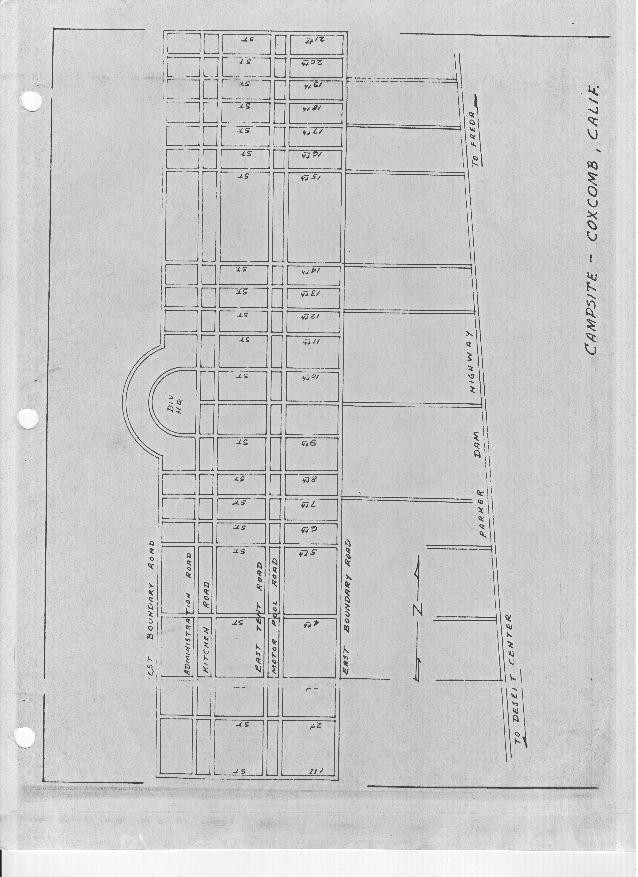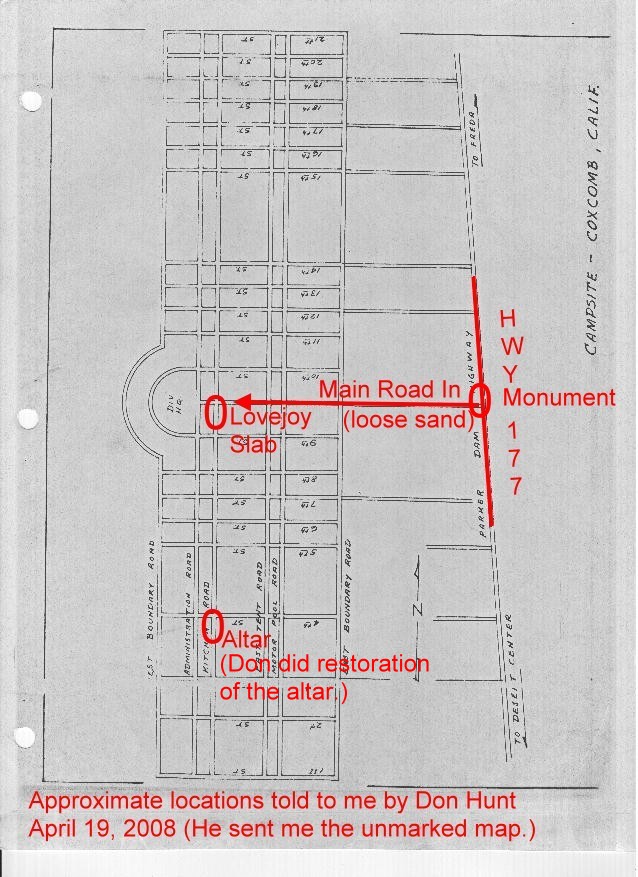|
Cautions: This is not territory that most people are familiar with. It is isolated desert, with no one around for 15 miles in any direction. So here are a few cautions about visiting the area.
I have to thank the folks at the Patton Museum at Chiriaco Summit. Even with verbal directions, I still had to make two trips out there, since the only thing visible from the road is the monument -- and it is easy to miss that if you are not looking for it.
From the Desert Center exit off of Interstate 10, take California Highway 177 north. There are white markers every mile, numbering from 0 at the Interstate. There are also frequent roadside emergency phones -- keep a watch on these so that you always know where the last one you passed was at, in case you get into trouble.
As you go north on 177, there are telephone poles on the left side of the road. Watch for the place where the telephone poles end, which is just past the 15 mile marker. The telephone poles actually turn left there. Continue on to the 17 mile marker, which is where the Camp Coxcomb monument is on the left (west) side of the road. The monument is at the junction with the sand road that leads west, which was the main road into the camp. (See map below.) Do NOT use that road unless you have 4-wheel drive. It has deep loose sand, and you can easily get stuck there in a 2-wheel drive vehicle.
If you go back to the road that heads west from the 15-mile marker, this road was passable with a 2-wheel drive in May 2006. There are a few sites to the south (left as you drive in) of that dirt road. South of where the road meets the Los Angeles aqueduct, I found two concrete floor slabs of buildings. Further back toward 177 from the aqueduct, there is an undrivable road that goes off to the south (left side as you drive in, right side as you drive out), and if you follow it on foot, you will find what appear to be concrete piers and cables, possibly for some sort of small bridge.
There may be more there. The lady at the Patton Museum (at Chiriaco Summit, CA -- about 35 miles away) told me that where the mountains (the Coxcomb Mountains -- which are part of Joshua Tree National Park) comes close to Hwy 177 there are bunkers, but I did not see those. She also said that there is a chapel still out there somewhere, but I did not find that either.


|
Here are three GPS readings I took in March 2011 with the GPS Essentials app on my cell phone.
|
In 2013, someone stole the original bronze plaque. So the text of both plaques is given here.
|
Camp Coxcomb Desert Training Center California-Arizona Maneuver Area Camp Coxcomb was established at this site in the Spring of 1942. It was one of twelve such camps built in the southwestern deserts to harden and train United States troops for service on the battlefields of World War II. The Desert Training Center was a simulated theater of operations that included portions of California, Arizona and Nevada. The other camps were Young, Granite, Iron Mountain, Ibis, Clipper, Pilot Knob, Laguna, Horn, Hyder, Bouse and Rice. A total of 13 infantry divisions and 7 armored division plus numerous smaller units were trained in this harsh environment. The Training Center was in operation for almost 2 years and was closed early in 1944 when the last units were shipped overseas. During the brief period of operation over one million American soldiers were trained for combat. This monument is dedicated to all the soldiers that served here, and especially for those who gave their lives in battle, ending the Holocaust & defeating the armed forces of Nazi Germany, Fascist Italy and Imperial Japan. Plaque placed by the Billy Holcomb Chapter of the Ancient & Honorable Order of E Clampus Vitus, the Veterans of the 6th Armored Division, the 7th Armored Armored Division Association and in cooperation with the Bureau of Land Management, Needles Resource Area.
|
|
Camp Coxcomb Desert Training Center California-Arizona Maneuver Area Camp Coxcomb was established at this site in the Spring of 1942. It was one of fifteen such camps built in the southwestern desert to harden and train United States troops for service on the battlefields of World War II. The Desert Training Center was a simulated theater of operations that included portions of California, Arizona and Nevada. The other camps were Young, Granite, Iron Mountain, Ibis, Clipper, Pilot Knob, Laguna, Horn, Hyder, Bouse and Rice. A total of thirteen infantry divisions and seven armored divisions plus numerous smaller units were trained in this harsh environment. The Training Center was in operation for almost 2 years and was closed early in 1944 when the last units were shipped overseas. During the brief period of operation over one million American soldiers were trained for combat. The Sixth Armored Division was declared a liberating unit by the US Army's Center of Military History and the United States Holocaust Memorial Museum for the liberation of the Buchenwald Concentration Camp on April 11, 1945. This monument is dedicated to all the soldiers that served here, and especially for those who gave their lives in battle, ending the Holocaust and defeating the armed forces of Nazi Germany, Fascist Italy and Imperial Japan. Plaque placed by the Billy Holcomb Chapter of the Ancient & Honorable Order of E Clampus Vitus and the Veterans of the 6th Armored Division and the 7th Armored Armored Division Associations, in cooperation with the Bureau of Land Management, Needles Resource Area.
Re-Dedicated March 14, 2014 |
The Camp Young monument is much easier to reach from I-10 than is Camp Coxcomb. Take the Cottonwood exit for Mecca and Joshua Tree National Park and head north toward Joshua Tree National Park. Only about a quarter mile north of the freeway, you will see the sign saying that the Camp Young monument is 7/8 mile to the right. The road is dirt and is in washboard shape much of the way to the monument. But you can take your 2-wheel drive vehicle in and out if you drive cautiously. (I try to keep my left wheel on the mound in the center of the road, and I find that this avoids some of the washboard conditions -- but not all. The monument is on your left. Watch your odometer to count the 10ths of a mile. Since you are driving so slowly on the washboard road, you may think you have gone too far, but you probably have not. If you reach 1 mile in though, you have indeed gone too far somehow. The monument is just to the left of the road and very hard to miss. It is about 4 or 5 feet high.
Camp Young apparently included the area where the Patton Museum is now at Chiriaco Summit, CA (named for the Italian family who settled there and who established the museum). Thus there is also a monument outside the Patton Museum, which gives more information about Camp Young and also has a map of all of the camps in the Desert Training center.
|
Camp Young Headqaurters Desert Training Center California-Arizona Maneuver Area Camp Young, named after Lt. Gen. S. B. M. Young, the 1st Army Chief of Staff, was established at this site in the Spring of 1942. It was one of twelve such camps built in the southwestern deserts to harden and train United States troops for service on the battlefields of World War II. It was selected by Gen. George S. Patton, Jr., as the administrative headquarters for the Desert Training Center, a simulated theater of operations that included portions of California, Arizona and Nevada. The other camps were Coxcomb, Granite, Iron Mountain, Ibis, Clipper, Pilot Knob, Laguna, Horn, Hyder, Bouse and Rice. A total of 13 infantry divisions and 8 armored division plus numerous smaller units were trained in this harsh environment. The Training Center was in operation for almost 2 years and was closed early in 1944 when the last units were shipped overseas. During the brief period of operation over one million American soldiers were trained for combat. This monument is dedicated to all the soldiers that served here, and especially for those who gave their lives in battle, ending the Holocaust & defeating the armed forces of Nazai Germany, Fascist Italy and Imperial Japan. Plaque placed by the Billy Holcomb Chapter of the Ancient & Honorable Order of E Clampus Vitus, the Fourth Armored Division Association, the Fifth Armored Armored Division Association & the 104th Infanry Division Association in cooperation with the Bureau of Land Management, Indio Resource Area.
|
|
California-Arizona Maneuver Area The D. T. C. was established by Major General George S. Patton, Jr., in response to a need to train American combat troops for a battle in North Africa during World War II. The Camp, which began operation in 1942, covered 18,000 square miles. It was the largest military training ground ever to exist. Over one million men were trained at eleven sub-camps (seven in California). California Registered Historical Landmark No. 985 Plaque placed by the State Department of Parks and Recreation in cooperation with the General Patton Memorial Museum and the Bureau of Land Management, November 11, 1989. |
|
Camp Young Maj. Gen. George S. Patton, Jr., selected Camp Young as headquarters for the Desert Training Cente in March 1942. Camp Young was the administrative center for a simulated theater of operations that would eventually extend from Pomona, CA to Phoenix, AZ, from Yuma, AZ to Boulder City, NV, and would include a network of training facilities at Camps Clipper, Coxcomb, Granite, Ibis, Iron Mountain, and Pilot Knob in California, and Camps Bouse, Horn, Hyder, and Laguna in Arizona. Between 1942 and 1944, over one million men were trained on the surrounding desert and participated in the most realistic war games under the harshest conditions imaginable. In a very important sense, many battles of World War II were won on these desert lands during those maneuvers. This memorial is dedicated to the soldiers of the U. S. Army who participated in these events. The spirit which they displayed generated a spark that spread into every overseas theater in which they served |
|
January 9, 1840-September 2, 1924 The Desert Training Center Headquarters was named in honor of Lt. Gen. Samuel B. M. Young on May 12, 1942. As a Captain he served with distinction with the Army of the Potomac and later with the 8th Cavalry along the Mojave Road in California and Arizona. He commanded a brigade during the Spanish-American War in CCuba and later in the Philippine Islands where he was appointed military governor of northwest Luzon. In 1901 he was named President of the War College Board and went on to serve as the first President of the Army War College. In 1903 he was appointed the first Chief of Staff of the Army, a position he held until his retirement in 1904. |